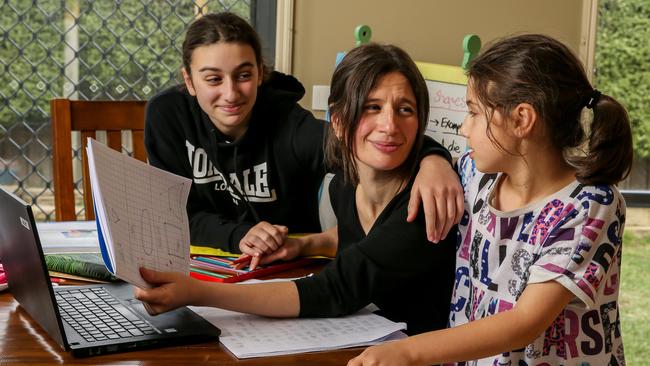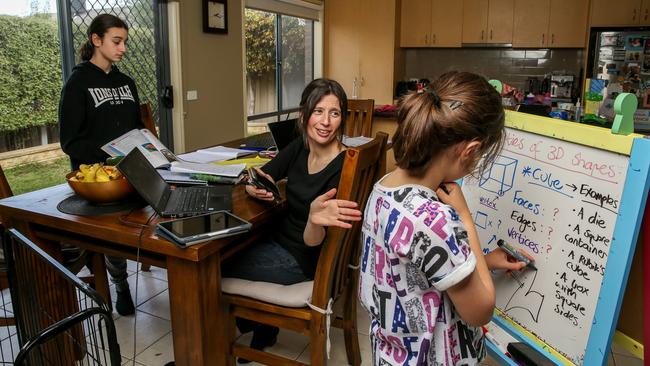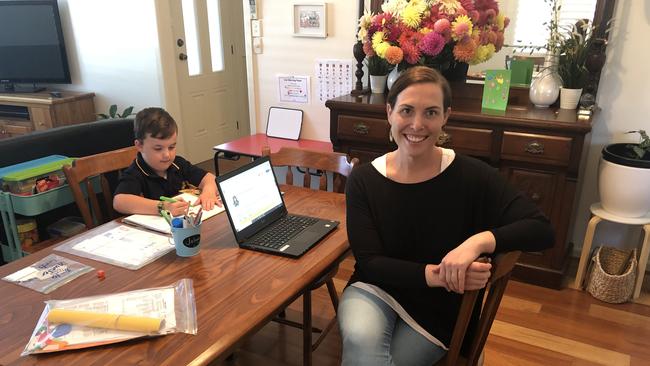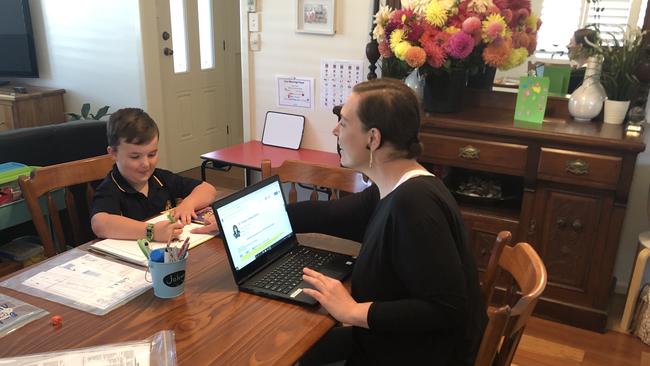Teachers reveal the ups and downs of remote learning
The shift to remote learning has been an upheaval for many teachers, but for those who teach students with intellectual disabilities or have kids of their own it has added another layer of difficulty. But despite the setbacks, these teachers are determined to do their best.
Education
Don't miss out on the headlines from Education. Followed categories will be added to My News.
Teaching has been undergoing a quiet revolution during the coronavirus crisis. The shift to remote learning has been an upheaval for parents and teachers, who are being praised for their ability to adjust in often very challenging circumstances.
Digital Learning and Teaching Victoria vice-president Matthew Harrison says these unforeseen circumstances have forced teachers to change their teaching methods.
“There are no time limits. You have to spend as long as it takes to get a good lesson off the ground while also helping parents learn how to use the software to guide their children,” Harrison says.
He says classes such as a chemistry experiment, physical education or special education can be an extra challenge when taught remotely.
“Some things just require a high level of interaction between teacher and student.
“So teachers have had to upskill very quickly and there’s so little research about how to teach children in an online environment. There’s very little information for teachers, so this is really cutting edge.”
But there have been exciting developments to emerge throughout this process.
“What we will see is a workforce that is more agile and can switch between online and face-to-face instruction so there will definitely be some benefits from this experience,” he said.
“It’s wonderful the way we’re working in partnership with parents to make the best of this situation that no-one wanted.”

MARY PAPADAKIS
Mary Papadakis could complain about the long hours and relentless stress of remote teaching while mothering two daughters.
But there is only one aspect of remote teaching she finds particularly challenging.
“There’s honestly nothing like that moment when you see a child who’s been struggling learn something new,” Papadakis says. “I miss seeing their little faces and hearing their stories.”
Papadakis teaches a Year 3 class of 25 children at a northern suburbs primary school. She is also mother to Zoe, 12, who is in Year 7 and Evie, 8, in Year 3 (above).
Together with her husband, Nick, it’s a close family, but even Papadakis admits her children may not appreciate her sense of humour when she starts the day by mimicking the school bell to get them out of bed.
“Zoe says, ‘Just no’.
“But we have to be organised. I’m online early to check emails, Zoe’s linked in with her teachers at 8.45am, and Evie starts by 9am. Once Evie has her tasks, I help her on and off while responding to emails and calling families, attending Skype meetings, and planning lessons for children with and without online access.”
There is also a learning plan, morning greeting, interactive learning tasks, and instructional videos to record and upload for her class. It’s usually after 10pm before she turns off her computer after rising at 6am.

While Zoe is relatively self-sufficient, there is homework to supervise once school stops, along with a lot more washing and housework because the whole family is at home.
“All of this is happening against a backdrop of being concerned for the physical and mental health of my children and my students who are confined to the home, but we’re doing this for the greater good and it’s not all doom and gloom. Evie and I have just been daggy dancing to a video clip I’ve used for the Year 3 students about 3D shapes, and I’m encouraging the students to get more active and to take part in regular brain breaks — short, fun activities such as dancing for a minute or two — to de-stress and have a laugh.
“My school is doing a great job under tough conditions and parents are being supportive. Parents don’t need to be teachers; they need to continue providing a safe and as happy an environment as they possibly can given the difficult circumstances so their children are able to continue to learn. And in reality, we have always been partners in their learning.”
WARREN DAWSON
Working remotely is not just a minor adjustment when teaching children with a range of intellectual disabilities.
As Warren Dawson, 37, of Clifton Springs, explains, it’s a major revolution.
“It’s a complete change in the pedagogy,” Dawson says.
“We were lucky because our school was already set up with a platform to deliver learning online. It had never been used before though, so there was some anxiety around that at first, especially because all our students have significant intellectual disability and parents have kids at different schools and their own challenges to face.”
Dawson teaches children from years 1-12 at Hamlyn Views School in Geelong. It’s a relatively new school with 75 students.

While teaching at home, he shares space with his wife, who also teaches students with disabilities; his 17-year-old son, who is studying VCE; and his 21-year-old daughter, who is a real estate agent.
“We only have a modest home so there are only so many spaces around the house where we can work, such as the kitchen table or the office and that’s an adjustment for us all,” he says.
“The other thing is that our students rely a lot on hands-on material. If there’s a written element to learn we always offer it in a video and audio format.
“That’s where the disconnect can take place, but we’re more mindful of it now and are learning to look through a different lens.”
Dawson has ensured that all of his students have internet access at home and he teaches about 10 children a day.
“Part of the challenge is the huge hours because I want to make things easier for the kids,” he says.
“I do think that a lot of mainstream schools are surprised by the work we do with our students and how much we can get out of them in this online world.”

LAUREN MADELEY
Single mum Lauren Madeley has made sure her six-year-old son, an only child, is surrounded by friends.
Every weekend, her son Johnny is playing with at least two friends and going to Auskick or swimming lessons.
But in isolation, mother-and-son time is the order of the day. As a Year 5 teacher in Sale, though, Madeley, 39, is challenged to find time to manage remote schooling and Johnny’s socialisation needs. She has become his mum, back-up teacher and buddy as well.
“Johnny misses his friends and the school environment because it’s a social outlet for him but I just talk to him and tell him it’s OK to be frustrated and to want the ‘rona-virus’ to disappear,” Madeley says.
“If I didn’t acknowledge that we’re in different circumstances at the moment, it would be harder for him. He’s already talking about what he’ll do on the first day that isolation ends and it’s to go next door to his friend’s house to have a play. He has such a positive outlook.”
She helps Johnny dress in his school uniform from Monday to Friday to help him understand that it’s still a school day but in a different location.

She is still packing a lunch box for Johnny so he doesn’t ask for snacks outside of timed breaks and in an attempt to maintain a schedule, while also accepting there will be days when it fails. A reward chart system also helps to motivate him to succeed at his tasks during the day because he responds best to learning when prompted.
Madeley, a teacher for 13 years, has become something of an inspiration for other mums during isolation since she posted a video sharing her tips and advice for remote learners. Her advice attracted more than 24,000 views on her Facebook page, Loz’s Kitchen.
“There are moments where the juggle is real but that’s when I step away from what’s going on and give myself a break and then we come back again and start again,” she says.
RELATED:
EVERYTHING YOU NEED TO KNOW ABOUT VICTORIAN SCHOOL CONFUSION
